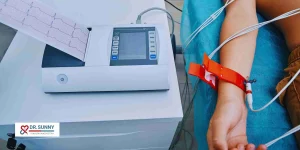As a cardiologist serving the communities of Brampton, Mississauga, Caledon, and Milton, Ontario, one of the most common and serious conditions I diagnose and treat is Coronary Artery Disease (CAD). This condition, which affects millions of people around the world, is a leading cause of heart-related complications, including heart attacks, heart failure, and arrhythmias such as atrial fibrillation and atrial flutter. As a heart doctor, it’s important to help individuals understand how CAD develops, the symptoms to watch for, and the treatment options available to prevent severe outcomes.
Coronary Artery Disease occurs when the arteries that supply blood to the heart muscle become narrowed or blocked due to a buildup of plaque—a condition known as atherosclerosis. Over time, this plaque restricts the flow of oxygen-rich blood to the heart, leading to chest pain, shortness of breath, and, if left untreated, more serious cardiovascular events.
If you’re experiencing shortness of breath, chest pain, palpitations, or dizziness, it could be indicative of underlying coronary artery disease. In these cases, seeking help from a cardiologist doctor near me is essential for diagnosis and appropriate treatment.
What is Coronary Artery Disease?
Coronary Artery Disease is a condition where the coronary arteries—the blood vessels that supply the heart with oxygenated blood—become blocked or narrowed. This process happens gradually over time as plaque, made up of fat, cholesterol, and other substances, builds up inside the walls of the arteries. This plaque formation is known as atherosclerosis.
As the plaque builds up, the arteries become less flexible and narrower, making it more difficult for blood to flow through them. As a result, the heart may not receive enough oxygen-rich blood, especially during times of physical activity or stress. In severe cases, the plaque may rupture, leading to the formation of a blood clot that can block blood flow entirely. This can cause a heart attack or other life-threatening conditions.
Risk Factors for Coronary Artery Disease
Several factors increase the likelihood of developing coronary artery disease. Some of the most common risk factors include:
- High Blood Pressure (Hypertension): Blood pressure that is consistently high can damage the blood vessels and contribute to plaque buildup, increasing the risk of CAD.
- High Cholesterol: Elevated levels of low-density lipoprotein (LDL) cholesterol, often referred to as “bad” cholesterol, contribute to the formation of plaque in the arteries.
- Smoking: Smoking accelerates the process of atherosclerosis, damaging the blood vessels and increasing the risk of CAD.
- Diabetes: People with diabetes are at higher risk for CAD because high blood sugar levels can damage blood vessels and increase plaque formation.
- Obesity: Excess weight puts additional strain on the heart and increases the likelihood of developing conditions such as hypertension and high cholesterol.
- Family History: A family history of coronary artery disease can increase your risk, especially if immediate family members (parents or siblings) had heart disease at an early age.
- Sedentary Lifestyle: Lack of physical activity contributes to obesity, high blood pressure, and high cholesterol—all of which increase the risk of CAD.
- Age and Gender: The risk of CAD increases with age, and men are typically at higher risk at a younger age compared to women. However, after menopause, a woman’s risk increases and may match that of a man’s.
Symptoms of Coronary Artery Disease
Coronary artery disease often develops gradually over many years and may not show noticeable symptoms in its early stages. Many people may not experience symptoms until the disease has progressed, which is why it is important to regularly consult a heart doctor near me if you have any risk factors. Common symptoms of CAD include:
- Chest pain (Angina): This is often described as a tightness, pressure, or discomfort in the chest. Angina may occur during physical activity or emotional stress and is a sign that the heart isn’t receiving enough oxygen-rich blood.
- Shortness of breath: As the heart struggles to pump blood effectively, fluid may build up in the lungs, leading to difficulty breathing, especially with exertion.
- Palpitations: The sensation of a racing or irregular heartbeat can be a sign of arrhythmias, such as atrial fibrillation or atrial flutter, which are common in individuals with CAD.
- Dizziness or Lightheadedness: Inadequate blood flow to the heart can cause feelings of dizziness or fainting, particularly upon standing up or during physical exertion.
- Fatigue: As the heart becomes less efficient at pumping blood, people with CAD may experience extreme fatigue, even with minimal physical activity.
- Pain in other areas of the body: CAD-related pain may radiate to the arms, back, neck, jaw, or stomach, often mistaken for other conditions such as gastrointestinal distress.
Diagnosis of Coronary Artery Disease
If you experience any of the symptoms associated with CAD, it is important to consult a cardiologist doctor near me as soon as possible. Diagnosis typically involves a combination of medical history review, physical examination, and diagnostic tests, including:
- Electrocardiogram (ECG): This test records the electrical activity of the heart and can detect irregular heart rhythms such as atrial fibrillation or atrial flutter, which may be indicative of CAD.
- Stress Test: A stress test monitors the heart’s response to physical activity, helping to identify areas where blood flow is restricted during exertion.
- Echocardiogram: This ultrasound-based test provides images of the heart, helping the cardiologist assess how well the heart is functioning and if there are any signs of plaque buildup or reduced blood flow.
- Coronary Angiography: This test involves injecting a dye into the coronary arteries to detect blockages or narrowing. It is often used when other tests suggest the presence of CAD.
- CT or MRI Scans: Advanced imaging techniques can also be used to get a detailed view of the coronary arteries and assess the extent of any blockages.
If you live in Brampton, Mississauga, Caledon, or Milton, visiting a cardiology clinic near me can provide you with the resources to undergo these tests and receive a comprehensive diagnosis.
Treatment Options for Coronary Artery Disease
While coronary artery disease is a chronic condition, it can be managed effectively with a combination of lifestyle changes, medications, and in some cases, surgical interventions. Treatment options include:
- Lifestyle Changes: Diet, exercise, and smoking cessation play a key role in managing CAD. A heart-healthy diet that is low in saturated fats and high in fruits, vegetables, and whole grains can help reduce plaque buildup. Regular physical activity strengthens the heart and improves blood flow.
- Medications: Your cardiologist may prescribe medications to help control risk factors like high blood pressure, high cholesterol, and diabetes. These medications may include statins, beta-blockers, ACE inhibitors, and blood thinners.
- Angioplasty and Stenting: In cases of significant arterial blockage, a procedure called angioplasty may be performed to open up the narrowed artery. A stent (a small mesh tube) may be placed to keep the artery open.
- Coronary Artery Bypass Grafting (CABG): In severe cases where multiple arteries are blocked, a coronary artery bypass may be necessary. This surgical procedure creates new pathways for blood to flow to the heart by bypassing the blocked arteries.
- Management of Arrhythmias: For patients with arrhythmias like atrial fibrillation or atrial flutter, medications, cardioversion, or even ablation procedures may be required to regulate the heart’s rhythm.
Conclusion: The Importance of Early Detection and Treatment
Coronary artery disease is a leading cause of heart attacks, strokes, and other cardiovascular issues. If you are experiencing chest pain, shortness of breath, palpitations, or dizziness, it is essential to seek help from a best cardiologist to determine the underlying cause and begin appropriate treatment. Early detection and intervention can significantly improve outcomes and prevent complications.
Whether you are seeking a cardiologist Mississauga, cardiologist Brampton, or simply searching for a heart doctor near me, ensure that you consult a trained and experienced cardiologist to protect your heart health. By managing risk factors, adopting healthy lifestyle choices, and following prescribed treatment plans, you can reduce the impact of coronary artery disease and lead a healthier, longer life.


